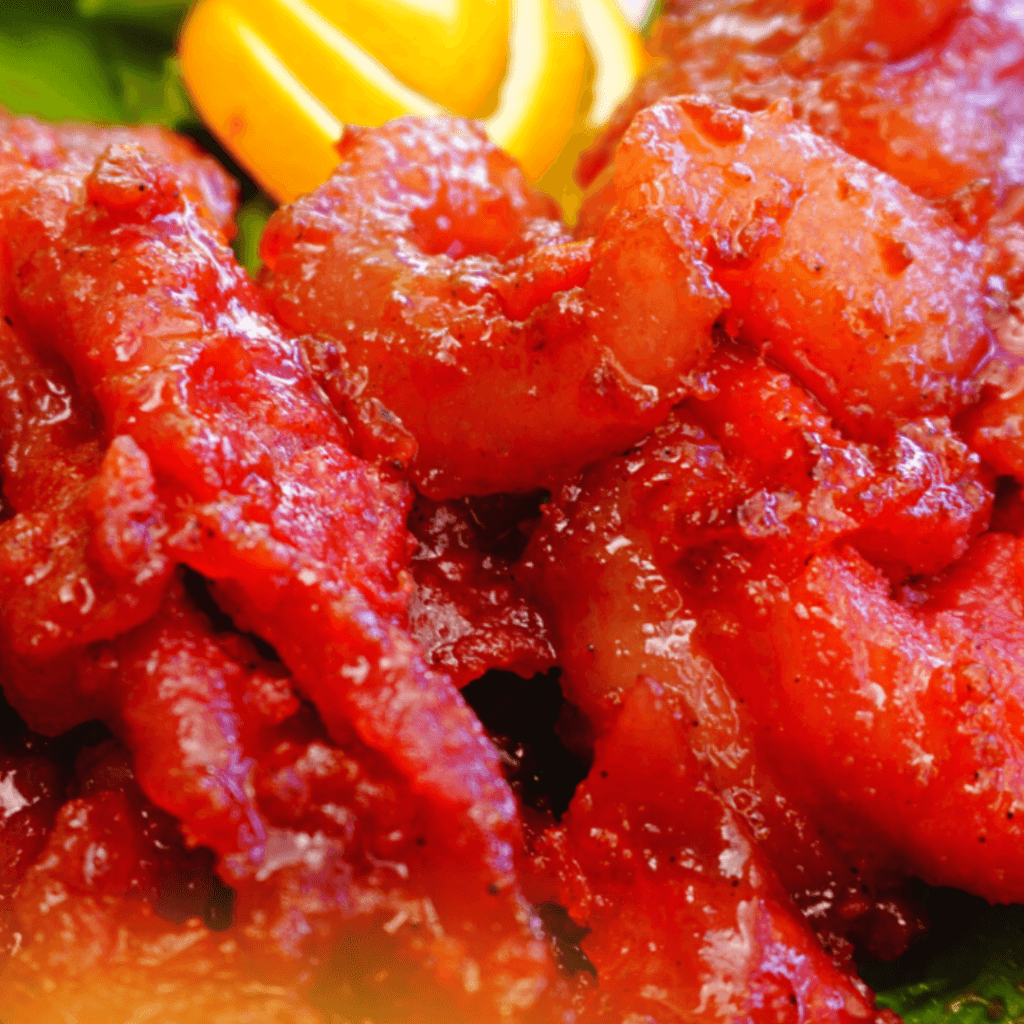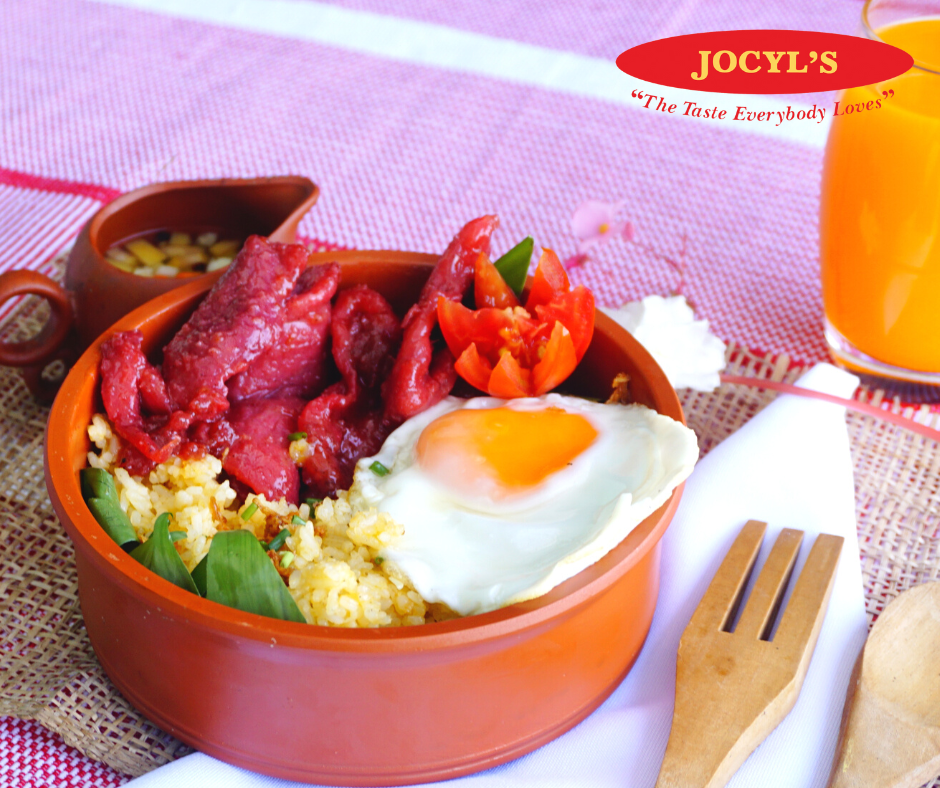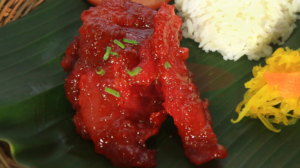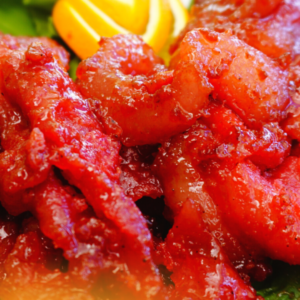
About Us
Jocyl's Food Products (a.k.a "Chorizo de Kalibo") is a bold and forward-thinking company whose goals are set to create surprising ways of developing and promoting our products. We are entrepreneurial and visionary in producing and marketing the best chorizo and other food products from our hometown - Kalibo, Aklan, Philippines.
About UsContact Info
- Tigayon Highway, Barangay Tigayon, Kalibo, Aklan
- +63362628688
- jocylsfoods@gmail.com
- Tigayon Highway, Barangay Tigayon, Kalibo, Aklan
- jocylsfoods@gmail.com
- +63362628688

Tocino vs Bacon: Unraveling the Sizzling Secrets of These Breakfast Favorites
-
Jocyl's Food Products > Blog > Food > Tocino vs Bacon: Unraveling the Sizzling Secrets of These Breakfast Favorites
Introduction to Tocino vs Bacon:
When it comes to breakfast delights, few things can match the heavenly aroma and mouthwatering taste of both tocino vs bacon. These savory treats have become staples in breakfast menus worldwide, but what sets them apart? In this article, we’ll delve into the sizzling secrets behind tocino vs bacon, exploring their origins, ingredients, flavor profiles, and cooking methods. So grab a seat at the breakfast table and let’s unravel the delicious mysteries of tocino vs bacon!
Tocino: A Taste of Tradition

Origins and Cultural Significance:
Tocino holds a special place in the hearts and palates of many cultures around the world. Its roots can be traced back to the Philippines, where it emerged as a beloved breakfast staple. The word “tocino” is derived from the Spanish term “tocino,” which means bacon or cured meat. However, Filipino tocino has evolved to have its unique characteristics and flavors over time.
In the Philippines, tocino is deeply ingrained in the culinary heritage and cultural traditions. It is commonly associated with breakfast, where it is often served alongside garlic fried rice and sunny-side-up eggs. This combination, known as “silog” (short for sinangag at itlog), has become an iconic Filipino breakfast meal. Tocino’s popularity has also extended beyond breakfast and can be enjoyed throughout the day in various dishes, such as tocino wraps or as a flavorful ingredient in stews and stir-fries.
Ingredients and Preparation:
Traditionally, tocino is made from pork, specifically from the pork belly or pork shoulder. The meat is sliced into thin strips, ensuring an optimal surface area for marination. The marinade plays a crucial role in infusing the meat with its signature flavors and tenderness.
The marinade for tocino typically consists of a combination of sugar, salt, soy sauce, vinegar, garlic, and various spices. Some variations may incorporate pineapple juice, calamansi (Filipino lime), or other local ingredients to add a unique twist. The meat strips are then thoroughly coated with the marinade, allowing them to absorb the flavors for a period of time, typically overnight, in the refrigerator.
Once marinated, the tocino is ready for cooking. Traditionally, it was sun-dried, giving it a slightly chewy texture and enhancing its preservation. However, modern methods often involve pan-frying or grilling the marinated meat until it achieves a caramelized and slightly charred exterior, while remaining tender and juicy on the inside.
Flavor Profile and Texture:
Tocino is renowned for its distinctive sweet and savory flavor profile. The marinade’s combination of sugar, soy sauce, and spices imparts a delectable sweetness, while the saltiness adds a delightful balance. The inclusion of garlic and other aromatic ingredients enhances the overall flavor complexity, resulting in a tantalizing taste experience.
In terms of texture, tocino offers a tender and succulent bite. The marination process helps break down the meat fibers, resulting in a softer texture. The slight chewiness adds a satisfying mouthfeel, complementing the interplay of flavors.
Whether enjoyed as part of a traditional Filipino breakfast or incorporated into other culinary creations, tocino’s rich history, unique flavor profile, and tender texture make it a beloved and iconic choice for breakfast enthusiasts and food lovers alike.
Bacon: The Classic Breakfast Indulgence

Historical Background:
Bacon, with its irresistible aroma and mouthwatering taste, has a rich history dating back centuries. Its origins can be traced to ancient civilizations, including the Romans, who were known for their fondness for salted pork. Over time, bacon gained popularity and became a staple in various cultures around the world.
In the United States, bacon became synonymous with breakfast during the 19th century. Its prevalence can be attributed to the rise of industrialized meat processing and the development of curing and smoking techniques. Today, bacon remains a beloved indulgence that graces breakfast plates, sandwiches, and culinary creations across the globe.
Curing and Smoking Process:
The process of transforming pork into bacon involves two main steps: curing and smoking. Curing is the preservation method used to enhance flavor and extend the shelf life of the meat. It typically involves the application of salt and a mixture of sugar and spices to the pork.
During the curing process, the pork belly, which is the most common cut of bacon, is coated with the curing mixture. The meat is then refrigerated for a specific period to allow the flavors to penetrate and the salt to draw out moisture. This process contributes to the distinctive taste and texture of bacon.
Following the curing stage, bacon undergoes smoking, which imparts the characteristic smoky aroma and flavor. The cured pork belly is placed in a smokehouse, where it is exposed to controlled smoke from various woods, such as hickory, applewood, or maple. The smoke infuses the meat, enhancing its taste and adding depth to the overall flavor profile.
Varieties and Cuts:
Bacon comes in various forms and cuts, offering a range of flavors and textures to suit different preferences. The most common cuts include:
- Pork Belly: This is the traditional and widely recognized cut used for bacon. It consists of layers of fat and meat, resulting in a balance of rich flavors and tenderness.
- Back Bacon: Also known as Canadian bacon or peameal bacon, this type is made from pork loin, which is leaner compared to pork belly. Back bacon is typically brined and rolled in cornmeal, giving it a slightly different taste and texture.
- Turkey Bacon: As an alternative to pork, turkey bacon has gained popularity among health-conscious individuals. It is made from turkey meat and is generally lower in fat and calories than traditional bacon.
- Flavored Bacon: In recent years, flavored bacon varieties have emerged, offering unique taste experiences. Examples include maple bacon, peppered bacon, or bacon infused with herbs and spices.
The selection of bacon cuts allows individuals to choose the flavor intensity, fat content, and overall profile that best suits their preferences and dietary needs.
Tocino vs Bacon: Ingredient Comparison
Meat Selection:
When it comes to tocino and bacon, the choice of meat plays a crucial role in defining their flavors and textures.
For tocino, pork is the primary meat of choice. The most commonly used cuts include pork belly or pork shoulder, which offer a good balance of lean meat and fat. The marbling in these cuts contributes to the tenderness and succulence of the tocino.
On the other hand, bacon is also typically made from pork, with the pork belly being the favored cut. The high-fat content in pork belly results in the desirable richness and melt-in-your-mouth texture that bacon is known for. However, it’s worth noting that bacon can also be made from other meats such as turkey, beef, or even duck, providing alternatives for those with specific dietary preferences or restrictions.
Seasoning and Marination Techniques:
Both tocino and bacon undergo marination processes to infuse them with their distinct flavors. However, the seasoning and marination techniques employed for each differ.
Tocino is characterized by its sweet and tangy flavor profile. The marinade for tocino typically includes a combination of sugar, soy sauce, vinegar, garlic, and various spices. Some regional variations may incorporate additional ingredients such as pineapple juice or calamansi for a touch of acidity and tropical sweetness. The meat is thoroughly coated with the marinade and allowed to marinate for a period of time, often overnight, to absorb the flavors.
Bacon, on the other hand, follows a different flavor profile. While it can be seasoned with spices and herbs, the prominent flavors in bacon primarily come from the curing and smoking process. A mixture of salt, sugar, and spices is applied to the pork belly, drawing out moisture and imparting a unique blend of savory, salty, and slightly sweet flavors. The cured pork belly is then smoked, further enhancing the taste with its characteristic smokiness.
Sweetness and Saltiness Levels:
One of the key differentiating factors between tocino and bacon lies in their levels of sweetness and saltiness.
Tocino leans towards the sweeter side, thanks to the use of sugar or sweeteners in its marinade. The sweetness adds a delightful contrast to the savory and tangy flavors, creating a well-rounded taste experience. The exact sweetness level can vary depending on personal preferences and regional variations, with some tocino recipes being more subtly sweet while others have a more pronounced sugary taste.
Bacon, on the other hand, tends to have a balanced combination of savory, salty, and subtle sweetness. The curing process involves the application of salt, which draws out moisture and helps preserve the meat. The result is a harmonious blend of flavors, where the saltiness complements the natural sweetness of the pork.
Ultimately, the differing sweetness and saltiness levels of tocino and bacon cater to distinct taste preferences, with tocino offering a sweeter profile and bacon providing a balance of savory and salty notes.
Tocino and Bacon: Flavor Face-Off
Tocino’s Sweet and Tangy Notes:
Tocino, with its origins in the Philippines, boasts a flavor profile that is both sweet and tangy. The combination of sugar, soy sauce, vinegar, and spices in the marinade gives tocino its distinctively sweet taste. The sugar caramelizes during cooking, creating a delightful glaze and adding depth to the overall flavor. The tanginess, often achieved through the addition of vinegar or calamansi juice, provides a refreshing and zesty element that balances the sweetness. This unique blend of flavors makes tocino a beloved breakfast delight, perfect for those who prefer a sweeter and tangier taste experience.
Bacon’s Salty and Smoky Goodness:
In the battle of flavors, bacon showcases its irresistible salty and smoky goodness. The curing process, which involves the application of salt and a mixture of sugar and spices, gives bacon its characteristic saltiness. This savory element, combined with the rich flavors from the spices, creates a mouthwatering taste that has become synonymous with bacon. The smoking process further enhances the flavor, infusing the meat with a distinct smokiness that adds depth and complexity. The marriage of saltiness and smokiness in bacon’s flavor profile is a culinary match made in heaven, appealing to those who crave a savory and smoky indulgence.
Versatility in Culinary Applications:
Both tocino and bacon offer exceptional versatility in the kitchen, making them valuable ingredients in various culinary applications.
Tocino’s unique sweet and tangy flavor makes it a versatile choice beyond breakfast. It can be used as a key component in stir-fries, giving a burst of flavor to dishes like tocino fried rice or tocino adobo. Tocino can also be enjoyed in wraps, sandwiches, or even as a pizza topping, adding a touch of sweetness and richness to the overall taste.
Bacon, with its savory and smoky profile, is a go-to ingredient in numerous dishes across cuisines. Its crispy texture and umami-packed flavor make it a popular addition to breakfast plates, sandwiches, salads, and pasta dishes. Bacon-wrapped appetizers, such as bacon-wrapped scallops or bacon-wrapped asparagus, are crowd-pleasers at parties and gatherings. The smoky notes of bacon can even elevate the taste of soups, stews, and sauces, adding depth and complexity to the overall flavor profile.
The versatility of both tocino and bacon allows them to shine in a wide range of culinary creations, appealing to food enthusiasts and chefs alike. Whether you’re looking for a sweet and tangy twist or a salty and smoky delight, both tocino and bacon offer flavors that can transform ordinary dishes into extraordinary culinary experiences.
Cooking and Serving Tocino and Bacon

Tocino: Grilling or Pan-Frying?
When it comes to cooking tocino, there are two popular methods that can bring out its delicious flavors: grilling and pan-frying.
Grilling tocino over an open flame or on a barbecue grill adds a delightful smokiness to the meat while allowing the excess fat to drip away. This method imparts a slightly charred exterior, creating a delicious contrast with the tender and juicy interior. Grilled tocino is often served with garlic fried rice, sunny-side-up eggs, and fresh tomatoes, forming the quintessential Filipino breakfast known as “tocilog.”
Alternatively, pan-frying is a convenient and popular way to cook tocino. It requires a frying pan or skillet, where the marinated tocino slices are cooked until caramelized and golden brown. The result is succulent tocino with a slightly crisp surface, perfect for pairing with garlic fried rice or as a filling for sandwiches and wraps. Pan-frying allows for precise control over the cooking process and is a preferred method for those who enjoy a caramelized finish and a tender texture.
Bacon: Crispy or Chewy?
When it comes to bacon, the debate between crispy and chewy textures is a matter of personal preference.
For those who prefer a crispy bite, cooking bacon until it reaches a golden-brown color and has a crunchy texture is the way to go. This can be achieved by baking bacon in the oven or frying it in a skillet over medium-high heat. Crispy bacon adds a satisfying crunch to breakfast sandwiches, salads, and even desserts like bacon-topped cupcakes or chocolate-covered bacon.
On the other hand, some bacon enthusiasts enjoy a chewier texture. Cooking bacon to a slightly less crisp state allows it to retain some tenderness while still being cooked through. This chewier bacon works well in BLT sandwiches, as a topping for burgers, or as a complement to creamy pasta dishes. The chewiness provides a more substantial bite and allows the bacon to shine as a flavorful ingredient in various recipes.
Creative Recipe Ideas:
Tocino and bacon offer endless possibilities for creative culinary creations. Here are a few ideas to inspire your kitchen adventures:
- Tocino Skewers: Thread marinated tocino onto skewers and grill them alongside pineapple and bell peppers for a delightful sweet and savory kebab.
- Bacon-Wrapped Dates: Wrap bacon around pitted dates and secure with toothpicks. Bake them until crispy, and enjoy the combination of sweet, savory, and crispy flavors in every bite.
- Tocino Fried Rice: Sauté diced tocino with garlic, onions, and cooked rice for a delicious twist on the classic fried rice. Add scrambled eggs and vegetables for a complete meal.
- Bacon-Wrapped Stuffed Chicken: Wrap bacon around seasoned and stuffed chicken breasts, then bake them until the bacon is crispy and the chicken is cooked through. The bacon adds smoky flavor and keeps the chicken moist.
- Tocino Breakfast Burrito: Fill a tortilla with scrambled eggs, sautéed tocino, shredded cheese, and your favorite breakfast ingredients. Roll it up and enjoy a satisfying and flavorful breakfast on the go.
These creative recipes showcase the versatility of tocino and bacon, allowing you to explore different flavor combinations and culinary experiences.
Health Considerations and Nutritional Value
Fat Content and Caloric Comparison:
When it comes to comparing the fat content and caloric value of tocino and bacon, it’s important to consider the nutritional aspects.
Tocino, being made from pork belly or pork shoulder, typically contains a higher fat content compared to bacon. The marbling in these cuts contributes to the succulence and flavor of tocino but also increases its fat content. It’s worth noting that the fat content can vary depending on the specific recipe and preparation method used.
Bacon, on the other hand, is known for its higher fat content as well. The fat found in bacon comes primarily from the pork belly, which contains layers of fat interspersed with lean meat. The amount of fat can also differ based on the specific cut and the trimming process.
In terms of caloric value, both tocino and bacon are relatively high due to their fat content. It’s important to consume them in moderation and as part of a well-balanced diet to maintain a healthy lifestyle.
Sodium Levels and Health Risks:
Sodium, commonly found in salt used during the curing process, is a significant consideration when it comes to the health risks associated with tocino vs bacon consumption.
Tocino marinades often contain soy sauce and other seasoning ingredients that contribute to its distinct flavor. These ingredients can increase the sodium content of tocino. Excessive sodium intake can lead to health issues such as high blood pressure and increased risk of heart disease.
Similarly, bacon’s curing process involves the application of salt, which contributes to its savory taste. The sodium levels in bacon can vary depending on the brand and preparation method. It’s important to read nutrition labels and choose low-sodium options whenever possible.
Moderation and Balanced Diet:
While both tocino and bacon are enjoyed for their flavors, it’s essential to consume them in moderation and as part of a balanced diet.
Including tocino or bacon as an occasional indulgence can be a part of a well-rounded eating plan. It’s recommended to balance their consumption with other lean protein sources, such as poultry, fish, or legumes. Additionally, incorporating plenty of fruits, vegetables, whole grains, and healthy fats into your diet is key to maintaining overall health.
For those concerned about their sodium intake, choosing lower-sodium alternatives or exploring homemade recipes with reduced sodium content can be beneficial. Additionally, opting for leaner cuts of meat or alternative options like turkey bacon can help reduce fat intake while still enjoying similar flavors.
Ultimately, moderation and balance are key when incorporating tocino or bacon into your diet. It’s important to be mindful of portion sizes, consider the overall nutritional composition of your meals, and make informed choices that align with your health goals.
Conclusion to Tocino vs Bacon:
In the epic battle of tocino vs bacon, it’s clear that both breakfast favorites bring their unique charms to the table. Tocino, with its traditional origins and sweet tangy flavors, offers a taste of cultural heritage, while bacon, with its smoky and salty goodness, has cemented its place as a classic indulgence. Whether you prefer the sweetness of tocino or the savory allure of bacon, these breakfast delights are sure to satisfy your cravings. Just remember to enjoy them in moderation as part of a balanced diet. So, the next time you’re faced with the choice between tocino vs bacon, embrace the sizzling secrets behind these breakfast favorites and let your taste buds guide you to breakfast bliss!
Jocyl’s Social Media:
https://www.facebook.com/jocylsfoods
https://www.instagram.com/jocylsfoods
https://www.twitter.com/jocylsfoods
https://www.pinterest.ph/jocylsfoods
https://www.tiktok.com/@jocylsfoodsproducts
Recent Posts
- The Ultimate Guide to Authentic Filipino Breakfast: Why Chorizo de Kalibo Is Taking 2026 to the next level!
- Ultimate Aklan Pasalubong Guide: Authentic Filipino Treasures
- How to Cook Longganisa Without Oil: Easy, Healthy & Delicious Guide
- Ultimate Guide: How to Cook Ilonggo Longganisa – Perfect Every Time!
- What is Ilonggo Food? Discover the Rich Flavors of Western Visayas Cuisine
Recent Comments
Archives
- October 2025
- September 2025
- August 2025
- July 2025
- May 2025
- April 2025
- March 2025
- February 2025
- January 2025
- November 2024
- October 2024
- September 2024
- August 2024
- June 2024
- March 2024
- February 2024
- January 2024
- December 2023
- November 2023
- October 2023
- August 2023
- July 2023
- June 2023
- May 2023
- April 2023
- March 2023
- February 2023
Tags
- Aklan
- Aklan Pasalubong
- Boracay
- Boracay Food
- Boracay Island
- Boracay Pasalubong
- boracay snacks
- Boracay Souvenirs
- Breakfast
- Chicken
- chicken tocino
- Chori Burger
- chorizo
- ChorizoDeKalibo
- chorizo recipe
- Delicacies
- embutido
- embutido recipe
- Filipino Chorizo
- Filipino Cuisine
- filipino food
- Filipino Longganisa
- Filipino Sausage
- foodie guide
- homemade
- Iloilo
- Iloilo Chorizo
- Iloilo Food
- Iloilo Longganisa
- Iloilo Pasalubong
- ingredients
- JocylsFoods
- longaniza
- longganisa
- longganisa recipe
- meat
- Pasalubong
- pinoy recipes
- pork tocino
- recipe
- Recipes
- skinless longganisa
- snacks
- tocino
- tocino recipe








